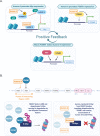Nuclear localisation of Aurora-A: its regulation and significance for Aurora-A functions in cancer
- PMID: 33981003
- PMCID: PMC8195736
- DOI: 10.1038/s41388-021-01766-w
Nuclear localisation of Aurora-A: its regulation and significance for Aurora-A functions in cancer
Abstract
The Aurora-A kinase regulates cell division, by controlling centrosome biology and spindle assembly. Cancer cells often display elevated levels of the kinase, due to amplification of the gene locus, increased transcription or post-translational modifications. Several inhibitors of Aurora-A activity have been developed as anti-cancer agents and are under evaluation in clinical trials. Although the well-known mitotic roles of Aurora-A point at chromosomal instability, a hallmark of cancer, as a major link between Aurora-A overexpression and disease, recent evidence highlights the existence of non-mitotic functions of potential relevance. Here we focus on a nuclear-localised fraction of Aurora-A with oncogenic roles. Interestingly, this pool would identify not only non-mitotic, but also kinase-independent functions of the kinase. We review existing data in the literature and databases, examining potential links between Aurora-A stabilisation and localisation, and discuss them in the perspective of a more effective targeting of Aurora-A in cancer therapy.
Conflict of interest statement
The authors declare no competing interests.
Figures




References
-
- Sen S, Zhou H, White RA. A putative serine/threonine kinase encoding gene BTAK on chromosome 20q13 is amplified and overexpressed in human breast cancer cell lines. Oncogene. 1997;14:2195–200. - PubMed
-
- Joukov V, De Nicolo A. Aurora-PLK1 cascades as key signaling modules in the regulation of mitosis. Sci Signal. 2018;11:1–26. - PubMed
Publication types
MeSH terms
Substances
Grants and funding
LinkOut - more resources
Full Text Sources
Other Literature Sources
Medical
Miscellaneous

